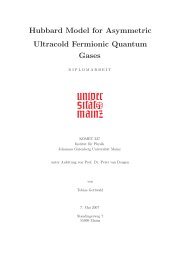5 Hirsch-Fye quantum Monte Carlo method for ... - komet 337
5 Hirsch-Fye quantum Monte Carlo method for ... - komet 337
5 Hirsch-Fye quantum Monte Carlo method for ... - komet 337
Create successful ePaper yourself
Turn your PDF publications into a flip-book with our unique Google optimized e-Paper software.
5.26 Nils Blümer<br />
E - 3.941 T 2 + 238 T 4<br />
-0.179<br />
-0.180<br />
-0.181<br />
-0.182<br />
0.000 0.001 0.002 0.003 0.004<br />
T 2<br />
U = W = 4<br />
◦ HF-QMC (∆τ→0)<br />
� weak-coupling CT-QMC<br />
△ hybridization CT-QMC<br />
Fig. 16: Comparison of energy estimates of the half-filled Hubbard model obtained within<br />
DMFT using different QMC based impurity solvers at fixed computational ef<strong>for</strong>t, with (approximate)<br />
leading terms subtracted. HF-QMC is competitive, here even more efficient, (only) after<br />
careful extrapolation∆τ → 0 [47].<br />
computing observables is that only runs are included in averages which are close to the solution<br />
in comparison to the asymptotic statistical error. For higher precision, the number of sweeps<br />
(and not only the number of measurements) must be increased.<br />
Let us, finally, stress that discretization errors can vary greatly between different observables<br />
and, due to the DMFT self-consistency, also between points in parameter space. This is clearly<br />
seen in Fig. 17: <strong>for</strong> the kinetic energy, the quadratic contribution to the Trotter error is significant<br />
only in the strongly correlated metallic phase; it is negligible in the insulator! This shows<br />
that rules <strong>for</strong> acceptable values of∆τ sometimes mentioned in the literature (e.g. ∆τU � 1) are<br />
of limited value; in fact, they cannot follow from the Trotter decomposition since this becomes<br />
exact both in the limits of weak and strong coupling. In the case of the double occupancy, the<br />
quadratic term is surprisingly small close to the phase transition (and has a maximum in the absolute<br />
value at U ≈ 3.5). However, in both cases the quartic terms are significant and irregular<br />
close to the phase transition which will in practice limit the reliability of extrapolations. Interestingly,<br />
some of the errors cancel in the total energy which makes numerically exact estimates<br />
of this observables particularly accessible <strong>for</strong> HF-QMC.<br />
5 Conclusion and outlook<br />
Hopefully, these lecture notes give a good first overview of the most important generic aspects<br />
of <strong>Hirsch</strong>-<strong>Fye</strong> QMC based <strong>method</strong> <strong>for</strong> calculating electronic properties within the dynamical<br />
mean-field theory. However, they are certainly not complete in any respect: important topics<br />
such as the minus-sign problem occurring in general multi-band and cluster DMFT calculations<br />
could only be touched upon; also, important literature is missing.<br />
The topics that we would have liked to discuss in an (yet unwritten) section on advanced aspects<br />
also include recent <strong>method</strong>ological developments such as the multigrid HF-QMC approach<br />
[45, 48] and our HF-QMC based implementation of real-space dynamical mean-field<br />
deviations from the exact solution.













